Disclosure: Meeple Mountain received a free copy of this product in exchange for an honest, unbiased review. This review is not intended to be an endorsement.
A common criticism of board games is how themes are often nonexistent or pasted on. Very few times do I come across a game with a theme concept that, even in extreme cases of intoxication, I would never come up with. World Exchangers fit that bill today.
Oligarchs have taken over the world in World Exchangers, yet peace is maintained. As one would expect, these oligarchs are you and your buddies at the table. Every 50 years, there is a weird tradition where these oligarchs will exchange full-blown cities with each other for profit. This ain’t no Monopoly. We are talking about Toronto, Mumbai, New York, and Warsaw. I’m sure someone smarter than me would say this criticizes capitalism or something.
Since this is about profits, you would assume the goal here is to get the most cash, and you are right. Like most games nowadays, there are many ways to pull it off.
Enough with the concept. We need to talk about that dry-erase marker, your first three starting cities, and the grid chart in front of you.
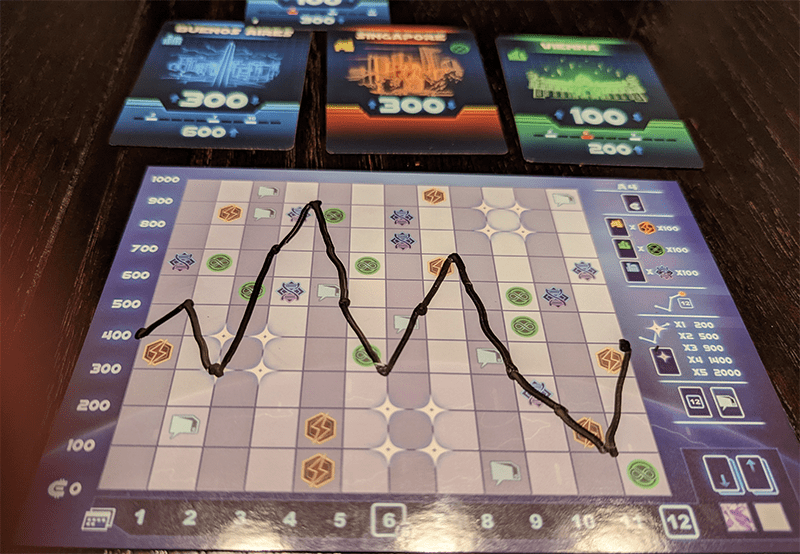
Montreal for two sheep?
A session of World Exchangers lasts 12 turns since there are 12 months in a year. On your turn, you either buy a city or sell a city from the central market of face-up cards. You can also buy two cities or sell two cities in one turn, but only once per game.
That grid chart represents your cash flow. Whenever you buy or sell a city, you mark the recent change on your grid and draw a line, making your grid look like a stock portfolio by the end of the game. While this looks nice from an aesthetic standpoint, there is a purpose behind this as well.
On the grid, there are four different icons. The first three represent the three city colors in the game: Green, Yellow, and Blue. When your line crosses these icons, you use them for end-game scoring. For example, if you have 3 blue icons and 3 blue cities, you score 900 points.
The fourth icon is Propaganda, and there is a separate board to keep track of everyone’s Propaganda level. Cross the icon, and move up the Propaganda board. At the end of the game, whoever has the highest position will score points, along with the second highest, and so forth.
What’s essentially happening here is you are spending the 12 turns of the game curating the value of city colors to you and maintaining the level of your Propaganda. All of this sounds good, yet it goes deeper.
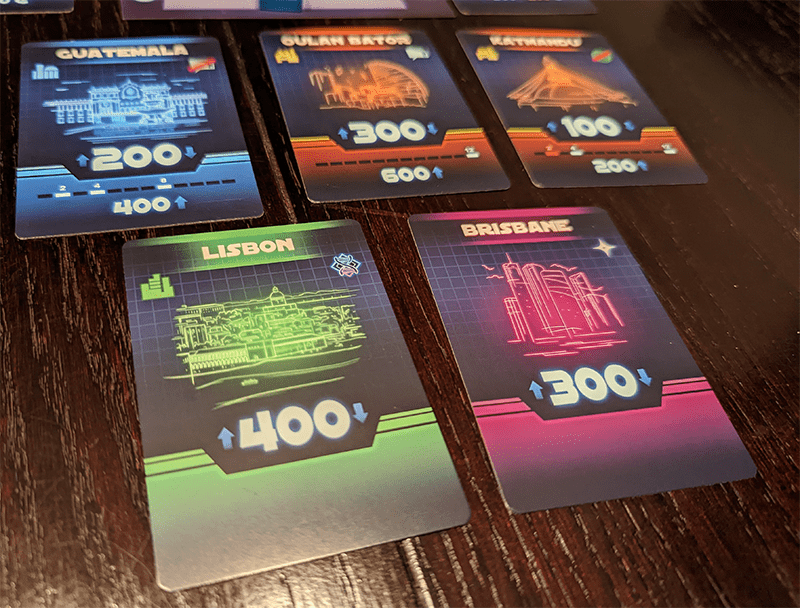
More lively than a morgue
Some city cards not only have a dollar value but their own icons as well. New York will get you two Propaganda levels, while Mumbai will remove a blue icon. What this means is you sometimes might hold onto a city that doesn’t even match your color, yet it’s propping up the other cities in your portfolio.
Cities can also fluctuate in value. At the bottom of some city cards is a list of months, and if you sell that city during those months, you get a bonus. Timing your sells becomes vital since it’s the only way to generate money. Furthermore, some months are in red, meaning you draw a circle around your dot to score more icons since it’s a celebration. Weird theme is weird.
Credit Zones are something to look for as well. These are the “stars” listed on your grid. Unlike the four icons, you don’t use your line to cross them. Instead, you need to land on them via buying and selling, and the more you get, the more points you earn.
As if that wasn’t enough, every game has a random mid-game and end-game objective to score additional points. Objectives can be anything from having the least cities by the end of round 6, or hitting the top and bottom of your grid by the end of the game.
Despite the simple turn structure of doing a single act of buying or selling a city, a lot is under the hood here. Maintaining your cash flow will have critical ramifications, either opening or closing opportunities throughout the game. To say the least, this is the type of optimization puzzle for people who fantasize about their heart rate monitor giving them an algebra problem instead of a plain number.
However, these were not my impressions of my first few games. I didn’t mention this before, but everyone starts with unique player power, and these powers have a side A and a side B. Side A is for people playing for the first time and gives the wrong impression of what World Exchangers is all about.
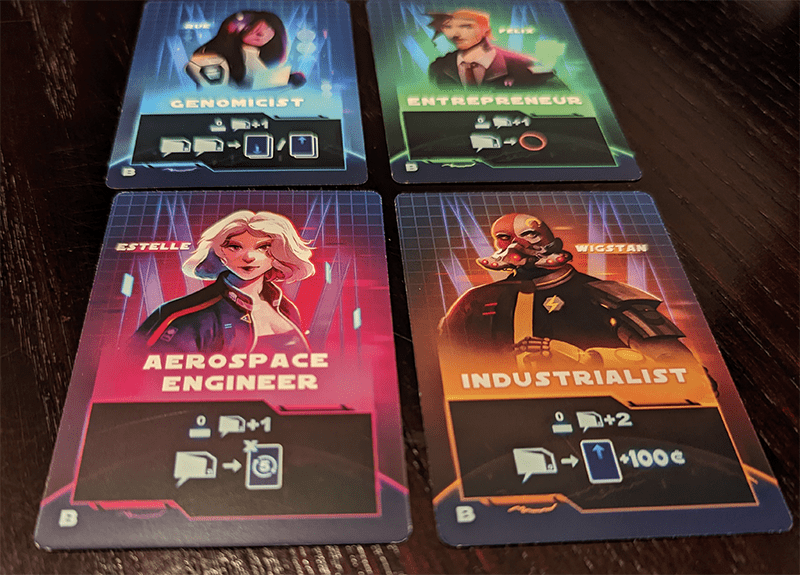
Judging a city by its skyline
World Exchangers is a set collection game that uses drawing lines on a grid to gain the sets instead of drafting cards like in other games, such as Sushi Go. The Side A powers give everyone a starting icon. What do you think happens if your starting icon is blue? You will go for more blue icons and blue cities because why wouldn’t you?
That was a significant issue in my first sessions. While there are various ways to score points, every game revolved around maximizing the starting icon, almost ignoring everything else. It was a dull experience, making all the other systems World Exchangers presents virtually meaningless.
This problem compounds further by the fact the central market for buying and selling cards is stiff. There are five cards in the central market at the start of the game, and it only fills up back to five when only two cards are remaining. When you sell a city, it doesn’t get discarded, it goes back to the central market. World Exchanges forces a refresh by the end of round 6, although it isn’t a complete solution. You barely go through the deck in a game session.
Due to how the market works and the starting icon, some players might be at a disadvantage because of the draw. If I have blue as my starting icon and there is only one blue card in the starting five, I’m already in a tricky spot compared to everyone else. It doesn’t work, and it surprises me that this made it to print.
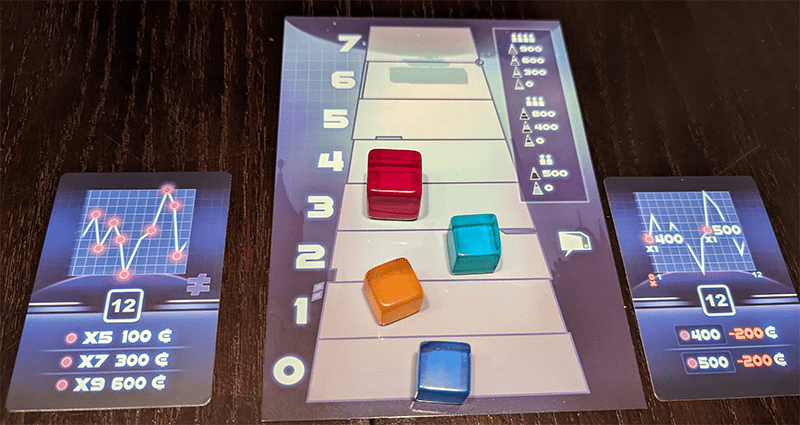
This isn’t even my final form!
When you play with Side B powers, the intentions of World Exchangers change dramatically and showcase the game’s true nature. You don’t have a starting icon anymore. In its place, you have an active ability that requires you to spend your Propaganda levels to activate, such as increasing the value of your sells, creating celebrating circles at will, or manipulating the central market. Now you have a tug-of-war situation since Propaganda can earn points at the end of the game, yet spending too little will lose the possibility of scoring more points. It’s a clever, engaging, and tough system to manage.
Also, it partially fixes the market issue, since one power allows a player to discard as many cards as they want from the market and redraw up to five. Finally, we get to see a few more cards in the deck.
Since nobody has a starting icon, this also means the value of the colors is under the complete control of the players. It’s possible that most of the table could go for one or two colors based on decisions they made a few turns ago and want to capitalize on it. This will eventually lead to a scarcity issue in the central market and force you to make a critical decision.
Some turns are easy since they align with what you are going for, while other turns can force you to make a poor decision. Like the actual stock market, there are waves of booms and busts, and the only thing you can do is try to ride it out better than everyone else. It’s those moments where World Exchangers grabs your wrists and pulls you in even if the player interaction is minimal here.
A unique destination
As someone well-versed in set collection games, I was skeptical about drawing lines on a chart as a vehicle to create sets. For starters, it reminds me of the roll-and-write genre, a genre that makes me look at hiking the Grand Canyon blindfolded as a viable alternative for my entertainment.
But after playing it a few times, I became accustomed to it. It puts you in a unique position and lets you experience a set collection game that hasn’t been done before. Moreover, there will be no easy way out of the many sacrifice plays and opportunity costs you will face here. It’s perfect for a 30-minute game where decision-marking still matters, but you don’t want your brain to burn too much. Despite some self-inflicted wounds, such as the Side A nonsense, low player interaction, and barely exploring the market deck, this is a marketplace worth trading in.


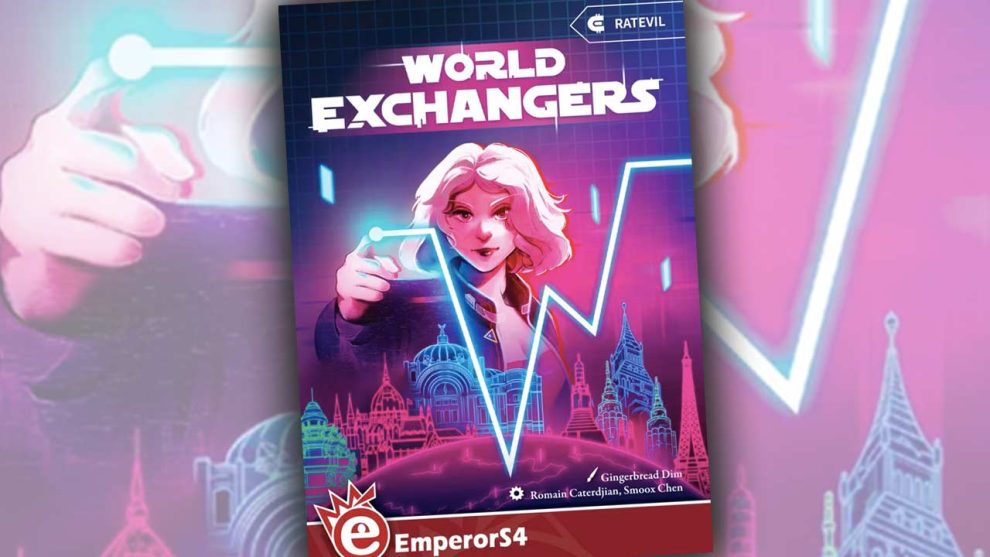








Add Comment